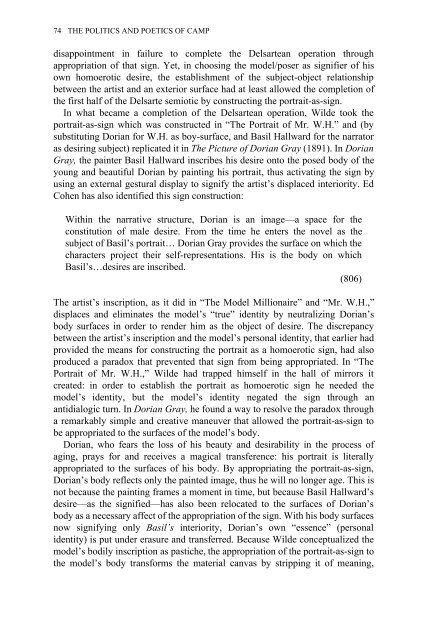Edited by Moe Meyer - Get a Free Blog
Edited by Moe Meyer - Get a Free Blog
Edited by Moe Meyer - Get a Free Blog
Create successful ePaper yourself
Turn your PDF publications into a flip-book with our unique Google optimized e-Paper software.
74 THE POLITICS AND POETICS OF CAMP<br />
disappointment in failure to complete the Delsartean operation through<br />
appropriation of that sign. Yet, in choosing the model/poser as signifier of his<br />
own homoerotic desire, the establishment of the subject-object relationship<br />
between the artist and an exterior surface had at least allowed the completion of<br />
the first half of the Delsarte semiotic <strong>by</strong> constructing the portrait-as-sign.<br />
In what became a completion of the Delsartean operation, Wilde took the<br />
portrait-as-sign which was constructed in “The Portrait of Mr. W.H.” and (<strong>by</strong><br />
substituting Dorian for W.H. as boy-surface, and Basil Hallward for the narrator<br />
as desiring subject) replicated it in The Picture of Dorian Gray (1891). In Dorian<br />
Gray, the painter Basil Hallward inscribes his desire onto the posed body of the<br />
young and beautiful Dorian <strong>by</strong> painting his portrait, thus activating the sign <strong>by</strong><br />
using an external gestural display to signify the artist’s displaced interiority. Ed<br />
Cohen has also identified this sign construction:<br />
Within the narrative structure, Dorian is an image—a space for the<br />
constitution of male desire. From the time he enters the novel as the<br />
subject of Basil’s portrait… Dorian Gray provides the surface on which the<br />
characters project their self-representations. His is the body on which<br />
Basil’s…desires are inscribed.<br />
(806)<br />
The artist’s inscription, as it did in “The Model Millionaire” and “Mr. W.H.,”<br />
displaces and eliminates the model’s “true” identity <strong>by</strong> neutralizing Dorian’s<br />
body surfaces in order to render him as the object of desire. The discrepancy<br />
between the artist’s inscription and the model’s personal identity, that earlier had<br />
provided the means for constructing the portrait as a homoerotic sign, had also<br />
produced a paradox that prevented that sign from being appropriated. In “The<br />
Portrait of Mr. W.H.,” Wilde had trapped himself in the hall of mirrors it<br />
created: in order to establish the portrait as homoerotic sign he needed the<br />
model’s identity, but the model’s identity negated the sign through an<br />
antidialogic turn. In Dorian Gray, he found a way to resolve the paradox through<br />
a remarkably simple and creative maneuver that allowed the portrait-as-sign to<br />
be appropriated to the surfaces of the model’s body.<br />
Dorian, who fears the loss of his beauty and desirability in the process of<br />
aging, prays for and receives a magical transference: his portrait is literally<br />
appropriated to the surfaces of his body. By appropriating the portrait-as-sign,<br />
Dorian’s body reflects only the painted image, thus he will no longer age. This is<br />
not because the painting frames a moment in time, but because Basil Hallward’s<br />
desire—as the signified—has also been relocated to the surfaces of Dorian’s<br />
body as a necessary affect of the appropriation of the sign. With his body surfaces<br />
now signifying only Basil’s interiority, Dorian’s own “essence” (personal<br />
identity) is put under erasure and transferred. Because Wilde conceptualized the<br />
model’s bodily inscription as pastiche, the appropriation of the portrait-as-sign to<br />
the model’s body transforms the material canvas <strong>by</strong> stripping it of meaning,


